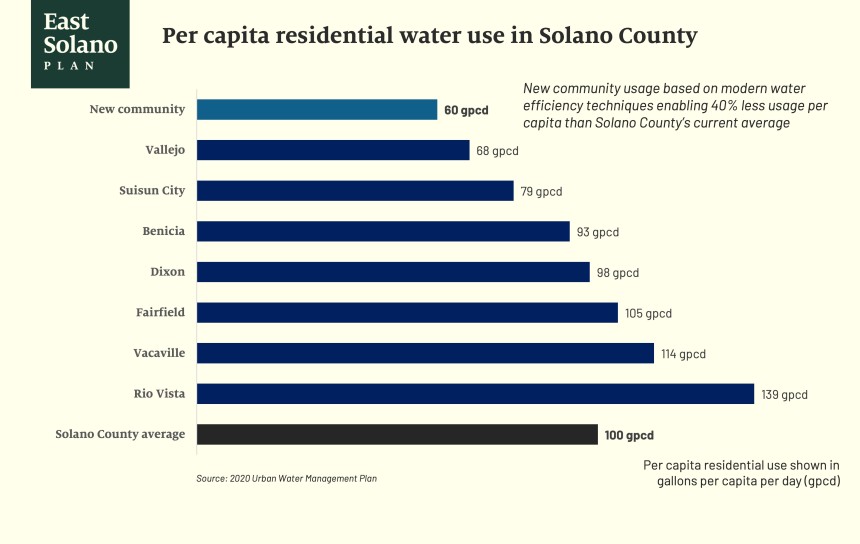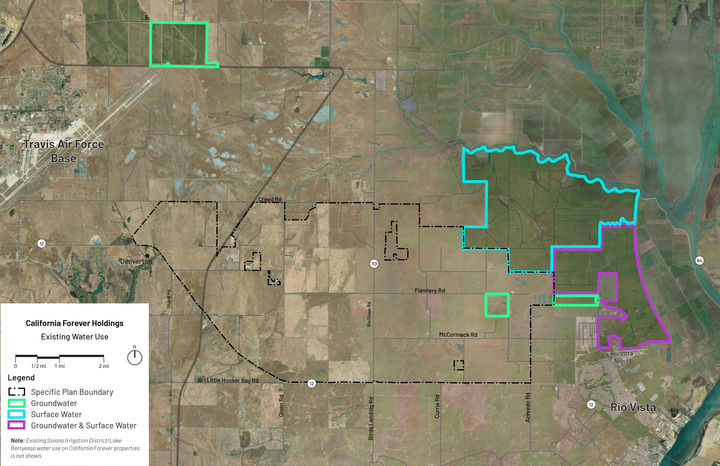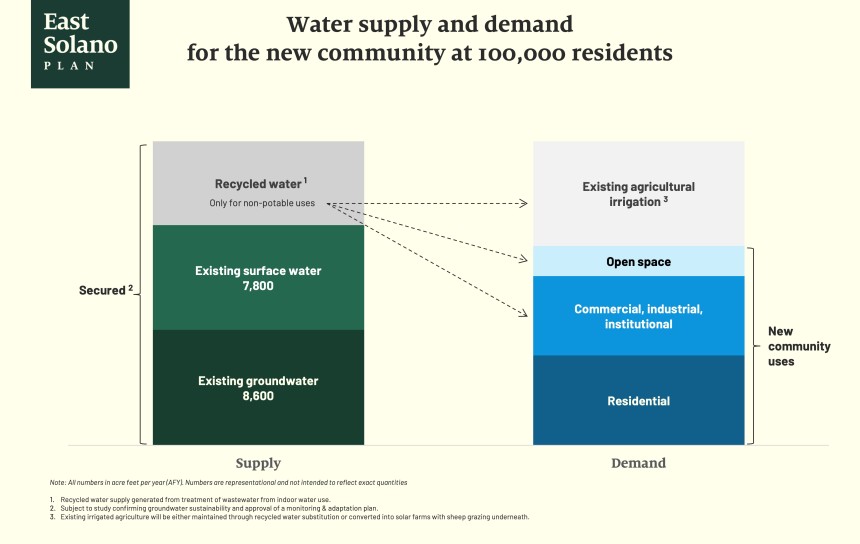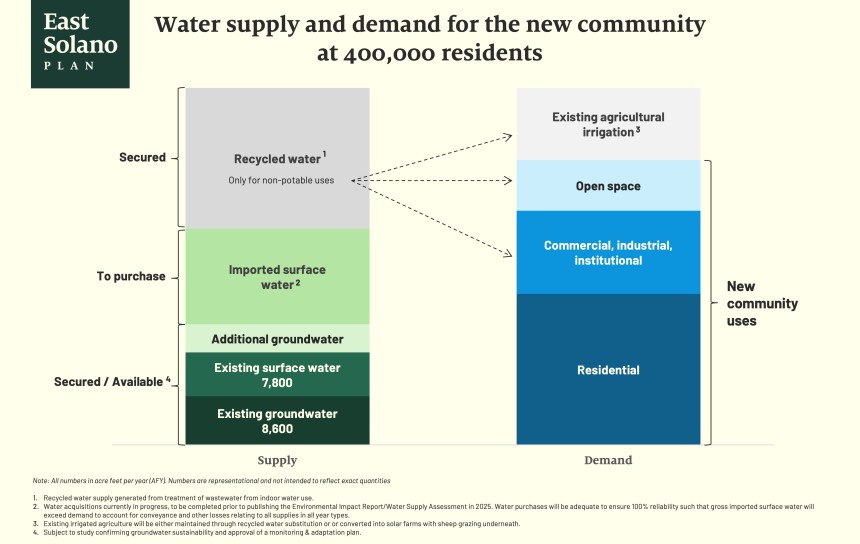California Forever secures water for the first 100,000 residents of the new community and demonstrates water supply for full build-out
Expert review complete
California Forever’s team of leading industry experts, including EKI Environment & Water, Best Best, & Krieger, and Holland & Knight, have completed an initial review for the East Solano Plan of: (1) water needs for the new community, and (2) water rights and site conditions associated with California Forever’s landholdings.
The review determined that the initial build out of the new community to 100,000 residents would require approximately 12,600 acre-feet per year (AFY) to provide water for all proposed residential, industrial, commercial, institutional, open space landscaping, and other uses. An acre-foot is a standard measure of water supply and demand - equivalent to a volume of water one foot deep on an area of one acre.
The review also determined that California Forever’s portfolio of over 60,000 acres of land in southeastern Solano County currently uses approximately 16,400 AFY of groundwater and surface water, and that at least 13,700 AFY and up to the full 16,400 AFY of these existing water supplies are legally and physically available for use by the new community. For comparison, 16,400 AFY is equivalent to more than the reported annual potable water use by Vallejo and Rio Vista combined.
As a result, this review confirmed that by repurposing and conjunctively managing the existing groundwater and surface water uses on its properties, California Forever has already secured more than enough water to supply the first 100,000 residents of the new community, including all associated commercial, industrial, and other land uses anticipated over the next 20 years.
However, the Water Guarantee of the East Solano Initiative requires that before we break ground on the first home or commercial building, we have secured or can demonstrate that we will be reasonably able to secure enough water not just for the first 20 years of build out, but for the full potential build out of the new community, including the maximum population of 400,000 people and all associated land uses. Our plan for meeting those demands is explained below.
This water plan is based on the principle that the new community water usage should not negatively impact others in Solano County. This includes maintaining agricultural lands currently in production by either supplying recycled water to substitute for water transferred to the new community or converting them to solar farms with sheep grazing underneath. To be clear, California Forever will not be using any water from Solano Irrigation District/Lake Berryessa for the East Solano Plan.
Water needs for the new community
Residential uses
By utilizing modern water efficiency techniques, we estimate that the average resident in the new community will consume approximately 60 gallons of water per day (0.067 AFY per person), which is about 40% less than Solano County’s current average. This means that 100,000 residents in the new community would use a total of approximately 6,700 AFY. The table below shows the estimated residential water consumption in the new community compared to other cities within Solano County:

Commercial, industrial, and other uses
With respect to non-residential water use needed for commercial, industrial, institutional, open space landscaping, and other land uses, we have estimated needs of approximately 53 gallons per person per day (0.059 AFY per person). This estimate is based on a review of comparable cities/water suppliers with populations matching our maximum build out, such as Alameda County Water District, Anaheim, and Irvine Ranch Water District, based on statewide 2020 Urban Water Management Plan (UWMP) data.
Applying this same estimate to the new community brings the total estimated water use for 100,000 residents, and all associated land uses, to 12,600 AFY, which is less than the 13,700 AFY available water supply that we have already secured. Water required for any population higher than 100,000 residents would scale up roughly proportionally.
Water sources for the full build out of the new community – a diversified approach
We are developing a diversified water portfolio to serve the full water supply required for the new community at the maximum build out of 400,000 residents. Our plan is to combine and conjunctively manage different sources of water. Conjunctive use means balancing the use of the various supplies during wet and dry periods to ensure a consistent and sustainable water supply.
1) Existing groundwater and surface water rights
Expert review has shown that California Forever’s properties currently use approximately 16,400 AFY of existing groundwater and surface water. This is equivalent to more than the reported annual potable water use by Vallejo and Rio Vista combined. Currently, this water is predominantly used for irrigation of underperforming almond orchards planted on low quality soils (e.g.,certain orchards located north of Travis AFB use groundwater) and for irrigated agriculture (mostly irrigated pasture located east east of the new community, with smaller amounts for orchards).

The use of water sources located both below and above the ground is governed by the complex water rights laws of California. California Forever holds certain rights to use water on its owned properties. Many of these rights have been exercised for many years for irrigation, domestic, and other purposes. California Forever has determined that a significant portion of the supply from these water rights would be available for the new community.
Our water team estimates that at least 13,700 AFY and potentially up to the full 16,400 AFY of this water can physically and legally be used to serve the planned new community and associated land uses. For the existing groundwater and surface water that will be conjunctively used for the new community, we anticipate:
converting the existing almond orchards to solar farms combined with sheep grazing and ecological restoration, pursuant to a study we are currently conducting with UC Davis;
converting the existing almond orchard in the new community to mixed use neighborhood development; and
for irrigated pasture, substituting the current irrigation sources with recycled water that will be generated within the new community and treated to appropriate reuse standards.
2) Additional groundwater and replenishment
Additional groundwater is groundwater located in basins immediately beneath the California Forever properties. None of these basins have been identified as being in overdraft by the California Department of Water Resources (DWR), meaning that the long-term water recharge to the basins exceeds water extractions.
A portion of this existing groundwater can be used to support the water demands associated with the new community, which will be defined based on a technical analysis of groundwater sufficiency in accordance with the Sustainable Groundwater Management Act (SGMA) and, where applicable, Groundwater Sustainability Plan (GSP). Site stormwater and recycled water will be managed to optimize replenishment of the groundwater basins, increasing return flows to the groundwater basins overall. Stormwater will focus on opportunities for green infrastructure features that promote water quality and infiltration to manage downstream flows.
3) Acquired water and providing for the future
The Water Guarantee of the East Solano Initiative requires that in the Environmental Impact Report, before we break ground on the first home or commercial building, we have secured or can demonstrate that we will be reasonably able to secure enough water not just for the first 20 years of build out, but for the full potential build out of the new community, including the maximum population of 400,000 people and all associated land uses. We must prove this through the comprehensive, state-mandated, and highly-regulated processes of a Water Supply Assessment and Water Supply Verifications.
By the time the Environmental Impact Report is publicly released, which we anticipate would happen in 2025, the statutory process for a Water Supply Assessment requires that we prove we have purchased or will reasonably be able to obtain all necessary water for the full potential build out of the new community, including during drought periods. Similarly, at the Water Supply Verification stage, which happens every time we file for a subdivision map for a specific phase of development, we are required to prove that we have fully secured the water necessary for the homes and industries being built on the subdivided land, including during drought periods.
To secure the additional water required to meet these criteria, we will be acquiring water and water rights from outside of Solano County. The current owner of these water rights and supplies would transfer them to the project, making the water available for use at the new community. Many of these water assets come with associated storage, allowing us to better manage water supply through drought years.
California has a robust market for trading water. Approximately 1.5 million AFY of water supplies are traded annually in California to help secure water for agricultural, municipal, and other uses (see State Water Board, Division of Water Rights Water Transfers Program). Purchasing imported surface water assets is a common way for cities and developers to secure the water supply needed for new neighborhoods and new communities.
For example, the Tejon Ranch Company, which is building Centennial, a new community with almost 20,000 new homes, acquired a contract to purchase 6,693 AFY from Nickel Family LLC. In addition, Tejon Ranch Company also secured State Water Project entitlements under long-term water contracts within the Tulare Lake Basin Water Storage District and the Dudley-Ridge Water District, totaling 3,444 AFY. Other examples include a Mojave Water Agency purchase of 14,000 AFY of State Water Project entitlement from another State Water Contractor and Santa Clara Valley purchase of State Water Contractor supply to serve the Newhall Ranch project. Transfers can be either permanent or temporary.
New habitat conservation projects or conservation from rotating agricultural land uses often frees up water elsewhere in the state that those landowners make available for purchase. The imported water can be conveyed through existing water bodies and the existing points of diversion on California Forever properties. We are currently in discussions regarding opportunities to partner in the implementation of such habitat conservation projects and utilize the water that becomes available.
4) Recycled water
Recycled water will be produced from treated wastewater generated from indoor water uses across the new community. Recycled water will be treated to appropriate standards for broad re-use within the new community – effectively creating a new, highly reliable water supply. As the community grows, more recycled water supply will become available for multiple applications, including: (1) surface water substitution where recycled water can be used to irrigate agricultural fields currently irrigated with surface water, (2) groundwater substitution where recycled water can be used to irrigate agricultural fields currently irrigated with groundwater, and (3) on site use where recycled water can be used to irrigate streetscapes, community parks, other landscaping, and potentially supply industrial and other indoor non-potable uses.
We are still completing design work that will determine the exact amounts, but we anticipate that the new community will generate approximately 25,000 to 35,000 AFY of recycled water from the treatment of indoor use of both existing water assets and imported surface water to be purchased for use in the new community. Recycled water will not be used for drinking, laundry, showering, or any other potable uses.
Balancing supply and demand
Based on the demand and supply figures provided above, by working with existing groundwater and surface water supplies as well as the recycled water generated from the initial uses, we can support a population of over 100,000 residents while sustaining existing agricultural lands:

With additional groundwater, imported surface water, and the incremental recycled water generated by the growth in uses, we can support the full population projected at 400,000 residents:

In summary
In all of our work, the key principle we follow is that our use of water sources should not negatively impact other users and communities in Solano County.
For example, we will implement an extensive monitoring and adaptive management program to ensure more sustainable groundwater use. None of the sources listed above would have negative impacts on other Solano County water users. They consist of either water we already have rights to and/or use on the 60,000+ acres held by California Forever, additional groundwater (subject to a groundwater sufficiency analysis), water we will purchase from outside of Solano County, and innovative and sustainable uses of recycled water to create a “new” and highly-reliable source of water.
We continue to develop our design and will be sharing additional information on our water plans over the coming months and through 2025 as we work on the Environmental Impact Report and the Water Supply Assessment, but to repeat, California Forever must and will prove that we have secured or reasonably can secure enough water for the full maximum theoretical build out, including all associated land uses, before the certification of the Environmental Impact Report takes place in 2025, and therefore before the first house or commercial structure is permitted to be built.
Frequently Asked Questions
Will the new community use any Solano Irrigation District supplies or Lake Berryessa water?
No. We will not use Solano Irrigation District/Lake Berryessa water for the new community. In addition to the 16,400 AFY of existing groundwater and surface water uses discussed above, our properties also currently use about 6,600 AFY of water from Solano Irrigation District/Lake Berryessa. However, that water will continue to be used for agricultural uses, and will not be used for the new community.
How will raw water supplies be made safe for drinking?
All water supplies will be treated onsite in new state-of-the-art water treatment plants that will be permitted through the State Water Board process that ensures all public drinking water systems meet the California Safe Drinking Water Act standards.
Where will wastewater be treated?
Wastewater will be treated in new water resource recovery facilities, which will be designed and permitted to enhance the circular economy of the new community by generating recycled water.